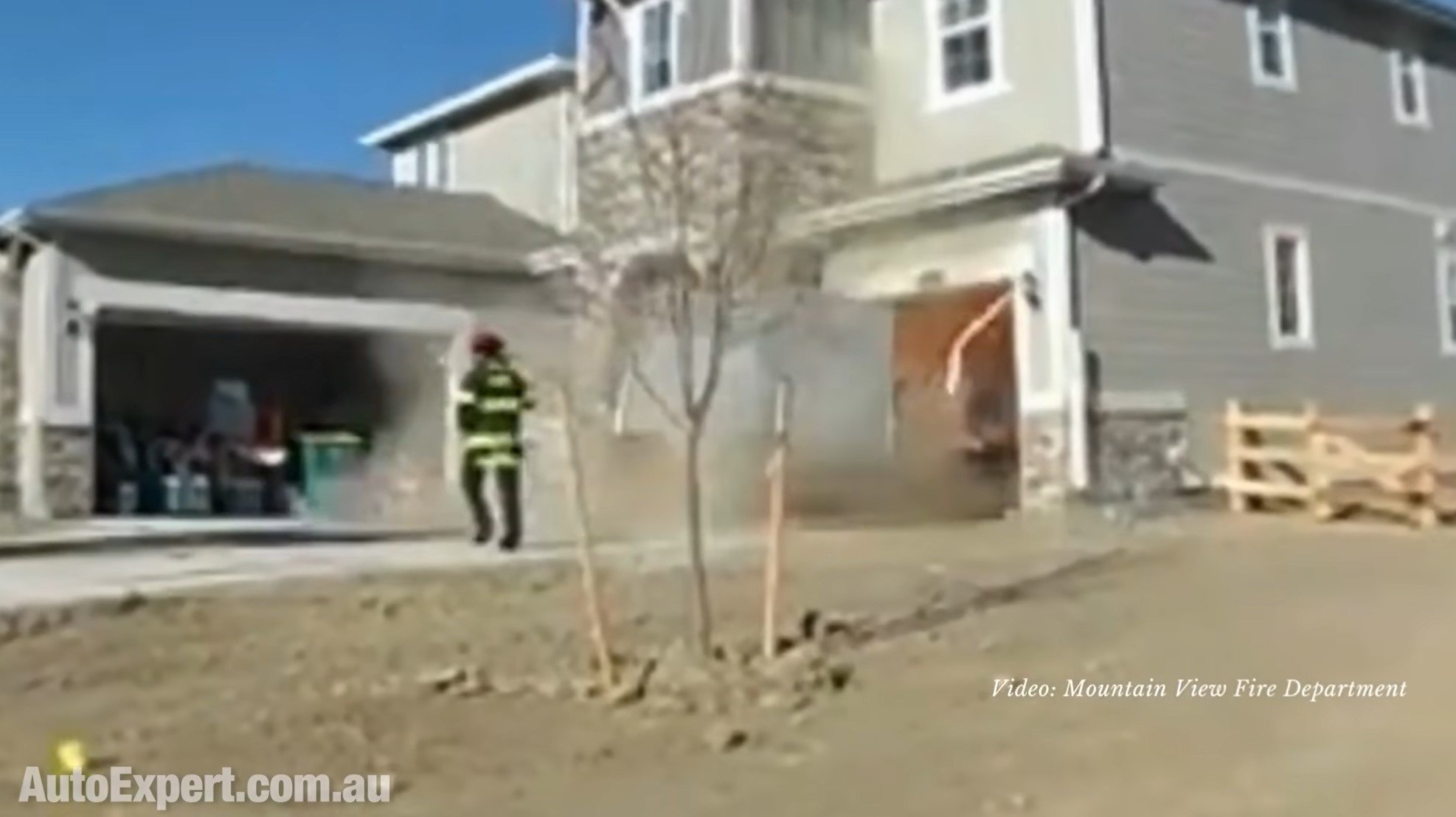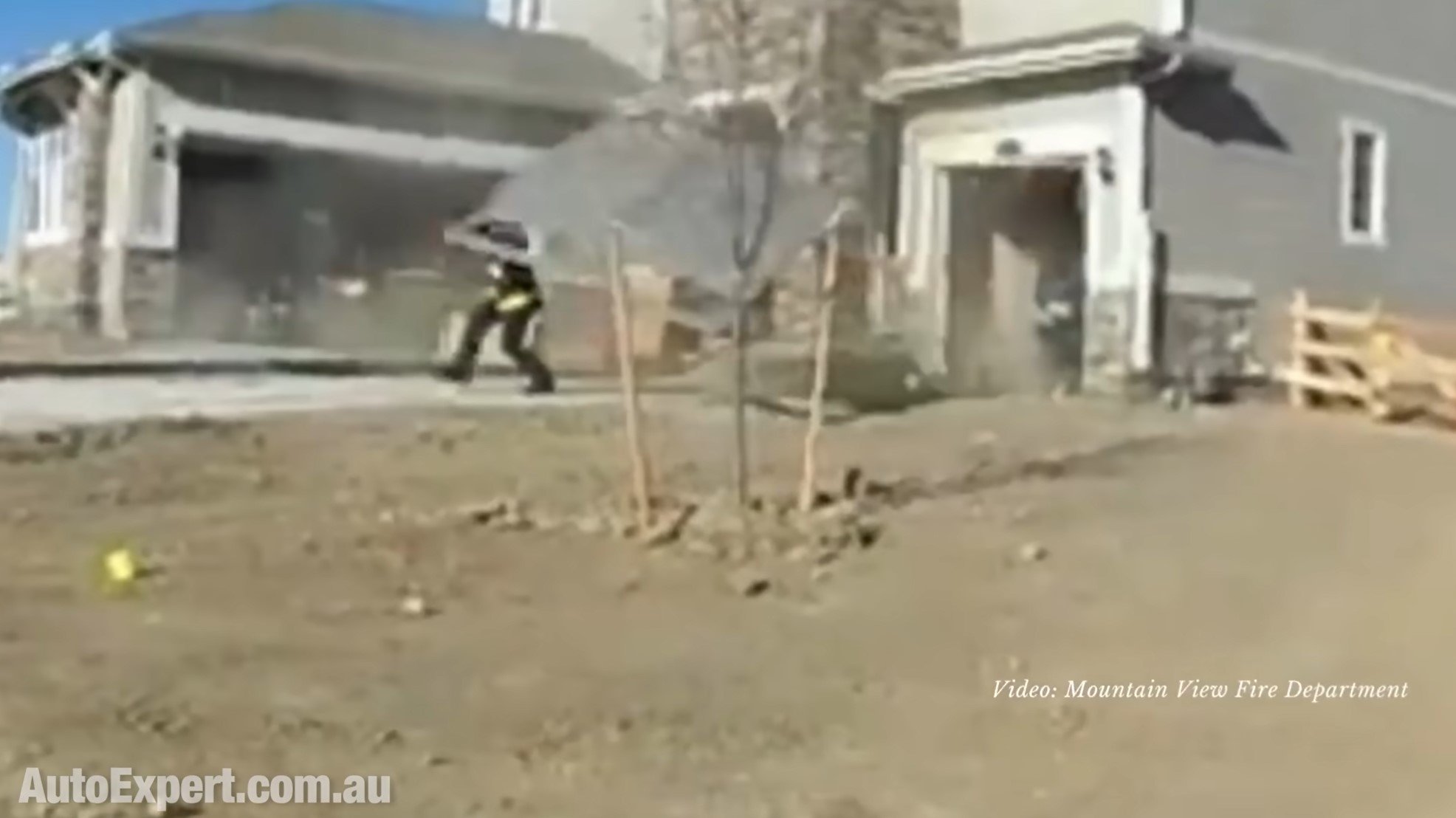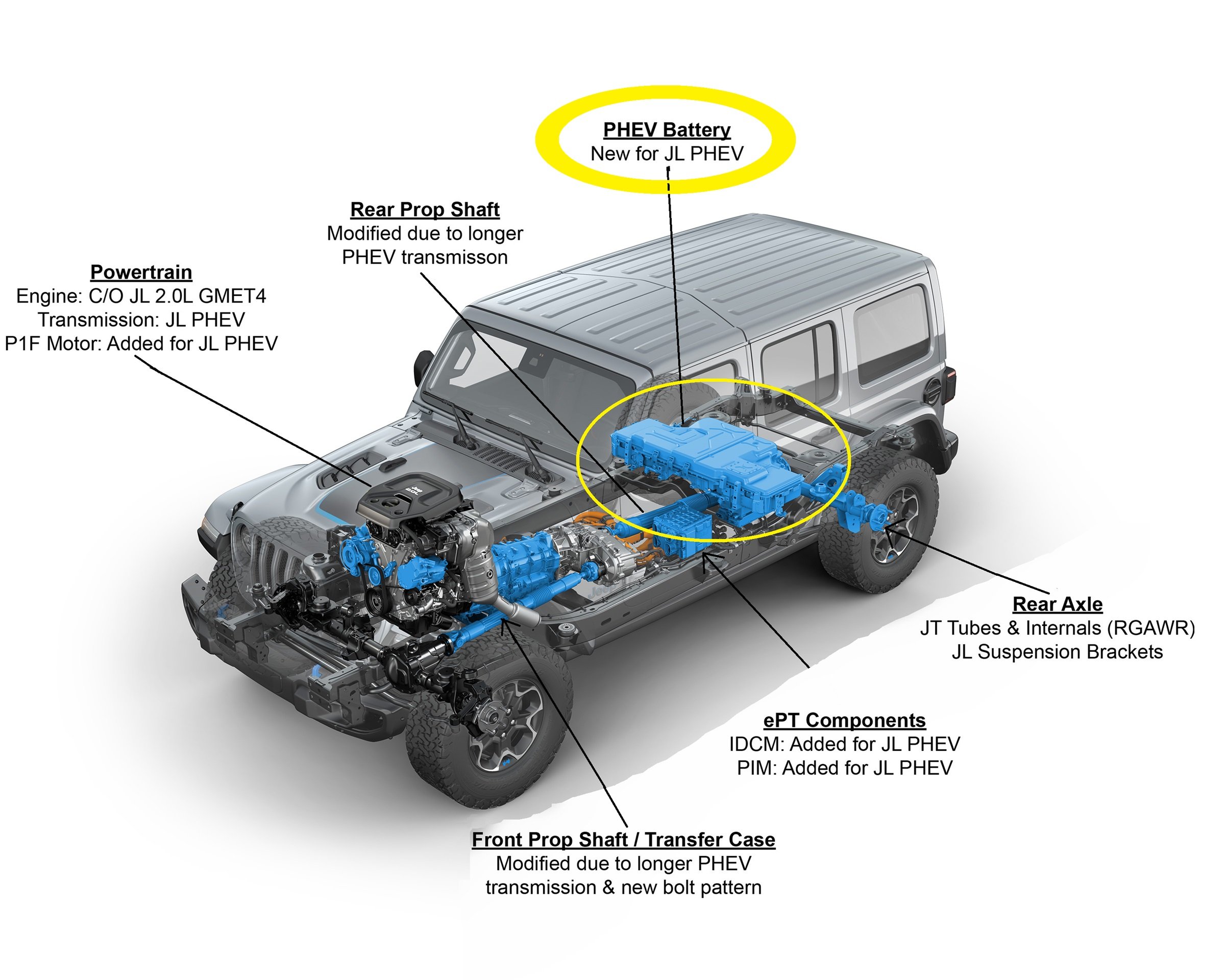EV battery smoke and vapour explosions: Authorities won’t admit the problem
If you think lithium-ion batteries being rolled out to the mass market with no safety oversight is a non-problem, here’s how quickly it can turn deadly in your garage, shopping mall or kitchen…
What you’re about to see is the result of an electric vehicle fire.
Are you ready? (click to englarge)
That was a single car garage door being unceremoniously hurled at the head of a firefighter who, thankfully, was wearing his helmet because the door left a dirty big gouge in it before coming to rest 30 feet from where it had previously been installed.
This event happened in Arizona in April and we really need to talk about what caused it, just like we did for the Fremantle Hwy: Mercedes EV battery burns ONE MONTH later >>
If you're someone like me in particular who is not anti-EV but quite concerned about the way these vehicles and this technology is being deployed, both here in Australia and around the world without all due care and consideration for things such as fire safety and safe disposal of batteries, this report aims to address that.
These kinds of structural change need to be happening in the background if we are to safely and responsibly deploy EVs on the roads.
What happened in this case was the rapid departure of that garage door caused when a cloud of vapor that was created by the off-gassing from a Jeep Wrangler 4Xe plug-in hybrid which has a 17 kliowatt-hour battery that was in thermal runaway.
So it was off-gassing this explosive vapor in an enclosed space. The vapor goes bang; it deflagrates, so that's the ‘gentle’ kind of explosion (if you can call the departure of a garage door like that towards a human being in any way gentle). Point being it wasn't a super sonic shock wave (detonation), which is what an explosion is actually defined as. So that’s nice.
Water has this great capacity to absorb thermal energy, roughly 4.2 kilojoules for every (Celsius) degree rise in temperature. It's miraculous stuff that we take for granted.
Check out Science -Vs- Lithium-ion batteries: EV firefighting, your questions and feedback >> for more on how awesome water is for fighting EV fires…
While the fire crew from Mountain View Fire Department were hosing down the vehicle, the vapor which was off-gassing from the battery ignited.
According to the official reports, three firefighters were inside the garage at the time but no serious injuries occurred, so I guess we should just be thankful and use this to learn so that future incidents like this might be less severe.
The battery in this vehicle is 17.3 kilowatt-hours, it's a 400-volt system (so not to be messed with) but bear in mind the size of this battery is really only about one quarter of the size of the battery that could be in an average fully battery-electric vehicle. So explosions of this nature would likely be proportional to the amount of materials that were experiencing thermal runaway. With a four-times as big battery, you do the math.
Official reports say it was unclear if the vehicle was previously damaged and the FireSafe report says that the chemistry in this vehicle’s battery is the general NMC kind, which stands for cobalt-nickel-manganese. Now, cobalt when it burns, off-gases toxic and flammable fumes and that means the full PPE costume for the first responders.
In May, incidentally, a similar event occurred in the same vehicle make and model Wrangler 4Xe, this time in New York. It started smoking while it was on the charger at a private residence and the point here to bear in mind is that the battery case itself can act like a pressure vessel. That’s bad.
If, or in the case of a Jeep product, when the battery has some internal malfunction and begins to heat up (like a short circuit or something) everything gets hot inside that aluminium box and when it gets to a predetermined temperature, it starts to enter thermal runaway. It emits all those nasty gases, it makes its own oxygen the gas, and the plumes are toxic and flammable.
This is a very serious situation and I notice that every time a ranking first responder is interviewed in Australia they tell you how safe the technology is, and that's true to certain extent. Obviously the technology is safe, the rate of fires and things of this nature with electric vehicles is no greater than that with combustion vehicles, despite some people saying it's safer. But I don't think they've taken into account the underlying modalities of a lot of the fires that take place such as arson, or the age of the vehicles that are burning.
Obviously electric vehicles are comparatively new. So you'd think, therefore, that they would be safer because age deteriorates all systems and the protections within them. But the problem with EVs is they're different and the nature of the fires is different, the hazards are different, there's a lot of different things about them that we're really not coming to terms with.
Keep reading to fully understand how this affects you either as an EV owner, or even as the neighbour of someone who owns one…
I'll help you save thousands on a new EV or PHEV here
Just fill in this form. No more car dealership rip-offs. Greater transparency. Less stress.
RISK MITIGATION
Here is a terrific photo from EV Fire Safe in their report which shows the mopping up efforts well and truly after the dust has settled after this immediate thermal runaway event is over:
What do you notice? Answer: The firefighters are all wearing their full PP - still.
It begs the obvious question to me, in cases where the dwelling is not totalled by events like this, what needs to occur so that the humans can go back and live there safely. What clean-up of all of these toxic heavy metal compounds is required and how long is that going to take, and how expensive is it going to be? What's that going to do for things like your home insurance premium in the future?
That's all worthy of discussion and I don't believe you're being anti-EV if you want to discuss things such as this.
EV Fire Safe says they've identified 15 of these vapor cloud explosions since 2010, and it's unclear whether they're just in America or globally, but 70% of these explosions have occurred in enclosed spaces.
The vapor cloud can build up inside the case of the battery itself which can become a pressure vessel and that can lead to a fairly violent explosion. In cases where the case is not a pressure vessel and the gas is escaping, then if the vehicle is in an enclosed room such as a garage, then the garage itself it can form an enclosed space where those toxic flammable vapors are looking for a source of ignition.
In less than two minutes, your living room, laundry or garage can become a very deadly place to be../.
Interestingly, this is not unlike the case of a fuel leak from a fuel tank that's been punctured, because petrol evaporates spontaneously to form a combustible mixture at basically every temperature that human beings ever live - in even places like Canada in the middle of winter - so these risks are similar. Although the gases from the battery are also highly toxic.
This source of ignition that they require to explode (to deflagrate) can be external like in a static electricity spark (like when fabric rubs together) or something like an electric arc from some sort of damage to electrical components in the car, but it can also be as simple as the friction of the gas escaping rapidly from a small aperture in the battery.
So where is the metaphorical PPE for the public? Where are the safety protocols, the building codes, the equipment and training upgrades, the designated EV parking bays, the ventilation systems, the public awareness about how to:
Stop. Drop. Roll.
or
Get down low and go-go-go
Remember that? When will we see the electric vehicle’s version of:
Smoke alarms save lives.
Here’s another incident involving a carpark full of mopeds, one of which is electric and commences thermal runaway:
It takes 90 seconds from the first hint of that gas appearing to the full-on deflagration which you might think of as a gentle explosion, but one which you would not want to be in.
What would you do in this situation?
I would suggest to you that if you were in an underground carpark and you were at some early point in the discovery of that smoke, 90 seconds is not a great deal of time to locate an exit, get to it, and get out of it to safety - especially if you have your young children or elderly parents to take care of. In these situations, it could be extremely dangerous.
In the future, to have large numbers of vehicles such as these, scooters, cars, e-bikes in underground enclosed spaces, like train stations, lobbies, carparks, tunnels - and I'm not saying it's going to happen every day - but it is going to happen, and we need to talk about it.
Just look at the Luton Airport fire >>
But this fire has already started in Australia: over 450 battery-related fires have been report in the last two years.
To mitigate the risk here, what I'd like to see is a sustained awareness and safety campaign explaining to consumers: do not park or (even worse) charge your plug-in hybrid or your full-battery EV in your garage. Do it outside, get the charger installed outside, because it's an all-weather deal, it doesn't have to be inside. Get it on an exterior wall of your home just like an external power point, and do the recharging on the concrete apron out the front, if you possibly can.
If you can't, it might be a great idea to recharge, if possible and if your security is not compromised, with the garage door open. Even if it's a rear door of the garage onto your internal yard, that sort of thing would help. You might want to fit a fan inside so that clean air flows into the space so that gases of this nature, if they do happen, can't build up and make a bad situation worse.
I'd much rather see greater discussion with professional firefighters and agencies of this nature about how to make this stuff safer, rather than just hear them endlessly declare on television that this technology is remarkably safe. Yeah, it is, meaning low probability. But it’s also a high consequence situation when it does happen.
What counter measures are we going to put in place? And bear in mind that it's not just the technology, it’s also the human error factor we need to protect ourselves from.


























xxxx